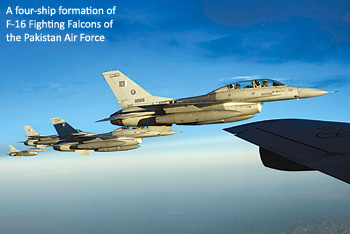INDIAN ARMED FORCES CHIEFS ON OUR RELENTLESS AND FOCUSED PUBLISHING EFFORTS

The insightful articles, inspiring narrations and analytical perspectives presented by the Editorial Team, establish an alluring connect with the reader. My compliments and best wishes to SP Guide Publications.

"Over the past 60 years, the growth of SP Guide Publications has mirrored the rising stature of Indian Navy. Its well-researched and informative magazines on Defence and Aerospace sector have served to shape an educated opinion of our military personnel, policy makers and the public alike. I wish SP's Publication team continued success, fair winds and following seas in all future endeavour!"

Since, its inception in 1964, SP Guide Publications has consistently demonstrated commitment to high-quality journalism in the aerospace and defence sectors, earning a well-deserved reputation as Asia's largest media house in this domain. I wish SP Guide Publications continued success in its pursuit of excellence.
Indo-Pak Air Balance

The US military support to Pakistan and strategic cooperation with China will help PAF unfold its modernisation plan by 2019 building up to 28 combat squadrons. As air power will be critical to victory, the IAF will need to maintain clear-cut edge over PAF.
While the world is embroiled in the Middle East, the emergence of China, belligerent North Korea, the epicentre of terrorism in nuclear Pakistan and nuclear India searching for its rightful place under the sun, action is shifting to the Asia-Pacific region. This also is the century for dominance by aerospace power. India and Pakistan, with large standing armed forces, have fought four wars and continue to be in conflict. There is therefore the need for balance in this sensitive South Asian region.
Indian Air Force
As the Indian Air Force (IAF) enters its 82nd year, it continues to dominate the region. From its small inheritance in 1947, it has grown to be the fourth largest air force of the world, gaining significant experience in the four wars with Pakistan, operations in Goa, Sri Lanka, the Maldives, Siachen and in United Nations Peacekeeping Missions. It has participated in joint exercises with the air forces of USA, UK, France, Singapore and UAE. With 1,60,000 personnel and 1,350 aircraft, of which 850 are combat aircraft, it is a sizeable force. The IAF is responsible for the air defence of the mainland and island territories, battlefield air support, and strategic and tactical airlift capability. The IAF also leads India’s military space capability. The ten remote sensing satellites currently in orbit are not dedicated military satellites, but with sub-meter resolution can have military applications. The IAF provides aid to civil administration for disaster management and has a special operations force ‘Garud’ tasked to protect critical installations, combat search and rescue, radar busting and other missions in support of air operations. With the induction of the Boeing C-17 and Lockheed C-130J-30, along with the existing IL-76 and An-32 aircraft, the IAF can paradrop a Brigade Group in battle. The Phalcon airborne warning and control system (AWACS), aerostats and airborne early warning and control (AEW&C) system greatly enhance warning and control capability. IL-78-based aerial refuelling capability is being enhanced with new inductions.
The IAF’s primary air dominance fighter is the Su-30MKI, of which 170 have been inducted against an order for 272. Currently under upgradation, the 66 MiG-29 air defence aircraft and 51 Mirage 2000 multi-role aircraft continue to be the backbone of the IAF and the upgraded MiG-21s (Bison) are also operational in significant numbers. The Hindustan Aeronautics Limited (HAL)- built LCA Tejas is slated to replace the MiG-21. The 139 upgraded Jaguars and 100 MiG-27s are dedicated strike aircraft. Induction of the Rafale MMRCA will enhance combat capability significantly. The Hawk AJTs too have close air support capability. The An-32 tactical transport fleet has been used in bombing role in the past. Large number of HAL-built Dhruv (ALH), Chetak and Cheetah light-utility helicopters, the medium-lift Mi-8 and Mi-17 variants and the heavy-lift Mil Mi-26 are part of the 350-plus helicopter fleet. Mi-25/35 attack helicopters will soon be complemented by the Apache. The Chinook will join the heavy-lift helicopter fleet. Six squadrons of IAI Searcher, Heron and Harpy will constitute the unmanned fleet.
Pakistan Air Force
Formed in 1947, the Pakistan Air Force (PAF) now has 65,000 personnel and 900 aircraft, 450 of which constitute the combat fleet. Pressler amendment resulted in an arms embargo on Pakistan in 1990. This slowed down all expansion plans for over a decade.
Pakistan’s combat fleet of 22 squadrons is dominated by four types. Fifty-four Lockheed F-16 A/B variants are now under midlife upgrade and 32 F-16 C/D are under induction. The Mirage III and Vs (150) and Chengdu F-7P/PG (180) continue to be in service. Two hundred fifty Sino-Pak JF-17 are under induction to replace F-7s and the A-5s. By 2015, PAF will induct two squadrons of Chinese Chengdu FC-20, a variant of J-10 and these could go up to 150 aircraft later. The Saab 2000 Erieye and Chinese Shaanxi Y-8 airframe based AEW&C provide early warning and control. Lockheed C-130, An-26, Airbus A-310, CASA CN-235, Boeing 707 heavy-lift transport aircraft and Fokker F-27 make up the transport fleet. PAF also has four IL-78 aerial refuelling aircraft. Alouette-III and the Mi-171 form the helicopter fleet. Crotale-4000 missile system is being replaced by MBDA Spada-2000. Pakistan has significant number of man-portable short-range air defence missiles.
The US military support to Pakistan and strategic cooperation with China will help PAF unfold its modernisation plan by 2019 building up to 28 combat squadrons. As air power will be critical to victory, the IAF will need to maintain clear-cut edge over PAF. Should India prepare for a two-front war and change strategy and tactics? For some answers, turn to Forum.





